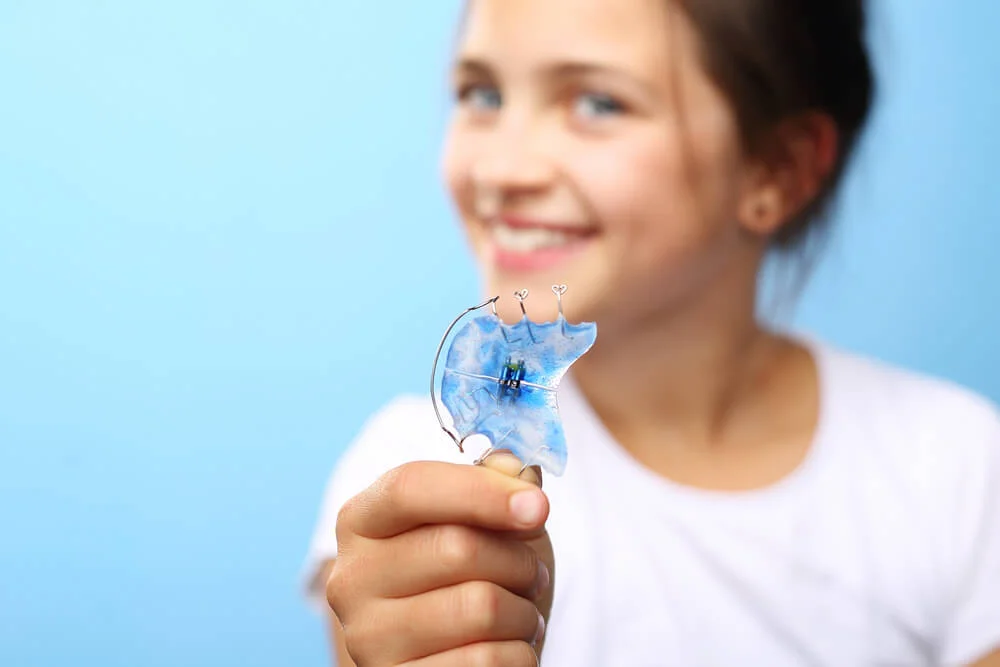Removable orthodontic appliances, which are mostly used in childhood, can be produced for jaw expansion in orthodontics, guidance of jaw growth, reinforcement after orthodontic treatment, as a placeholder after early deciduous tooth loss or to break habits such as tongue sucking.
The treatment success of removable appliances is closely related to the cooperation of the patient who will use the appliance. It is very important for patients to use these appliances as recommended by their orthodontists, for the correct duration and frequency. In addition, the appliances should be removed during eating and oral care. The appliance removed from the mouth should be cleaned once a day with clear water and a brush, and after drying, it should be kept in a box. Storing the removable appliance wrapped in a napkin usually ends up in the garbage. For this reason, you should not forget to get your special appliance box from your doctor.
The timing of orthodontic removable appliance treatment is very important. Following the growth and development stages correctly and starting treatment without delay makes it easier to solve many problems that will become more complicated in the future.
What are the orthodontic disorders that removable appliances can treat?
- Jaw stenosis
- Abnormalities in jaw curvatures
- The need for multiple placeholders in case of early extraction of deciduous teeth
- Crowding due to space constriction
- Improper position and angles of the teeth
- Intermittent teeth
- Maintenance of completed orthodontic treatments
- Prevention of bad habits
How are removable appliances produced?
First of all, measurements are taken from the jaw or jaws where the removable appliance will be made. In accordance with this measurement, removable appliances are produced in the dental laboratory in accordance with the instructions of the dentist who will carry out the treatment.
During the application session, the dentist can check the fit of the appliance in the mouth and make corrections when necessary.The dentist, who is convinced that the appliance is suitable for the mouth and function, explains the method of use to the patient and his/her relatives.
The treatment is continued by calling the patient for control at regular intervals. Completion of the treatment at the planned time is only possible if the patient strictly follows the doctor’s recommendations.
What are the conditions that patients should pay attention to?
- The appliances should be cleaned daily.
- Teeth should be brushed and flossed at least twice a day, before and after the appliance is removed.
- After the appliances are washed, they should be thoroughly dried and kept in their box.
- Appliances should be placed in and removed from the mouth as instructed by the dentist and the screws, if any, should be turned as often as recommended.
What are the advantages of removable appliances?
- If they are applied at the right age, treatments that cannot be performed with orthodontic braces at a later age can be performed successfully.
- Both the oral environment and the appliance can be cleaned easily because they can be put on and taken off.
- They can create simple, fast and economical treatment options.
- If necessary, it ensures that the subsequent wire treatment is shorter and more effective.
- Their use in allergic patients does not pose a problem.
- They provide easy treatment for orthodontic problems.
- Treatment success is quite high in cooperative patients.
- Removable appliances, which are mostly used at an early age, constitute the most effective treatment method in preventing and reducing the severity of orthodontic problems.
What are the disadvantages of removable appliances?
- Treatment is interrupted when the patients are not cooperative.
- Appliances can be damaged in case of misuse.
- There is a risk of loss.
- They need to be removed while eating.
- It may cause nausea in some patients.
- Careless patients may damage teeth and surrounding tissues during insertion and removal.
- When they are new to use, problems such as inability to control saliva flow and difficulty speaking may occur




